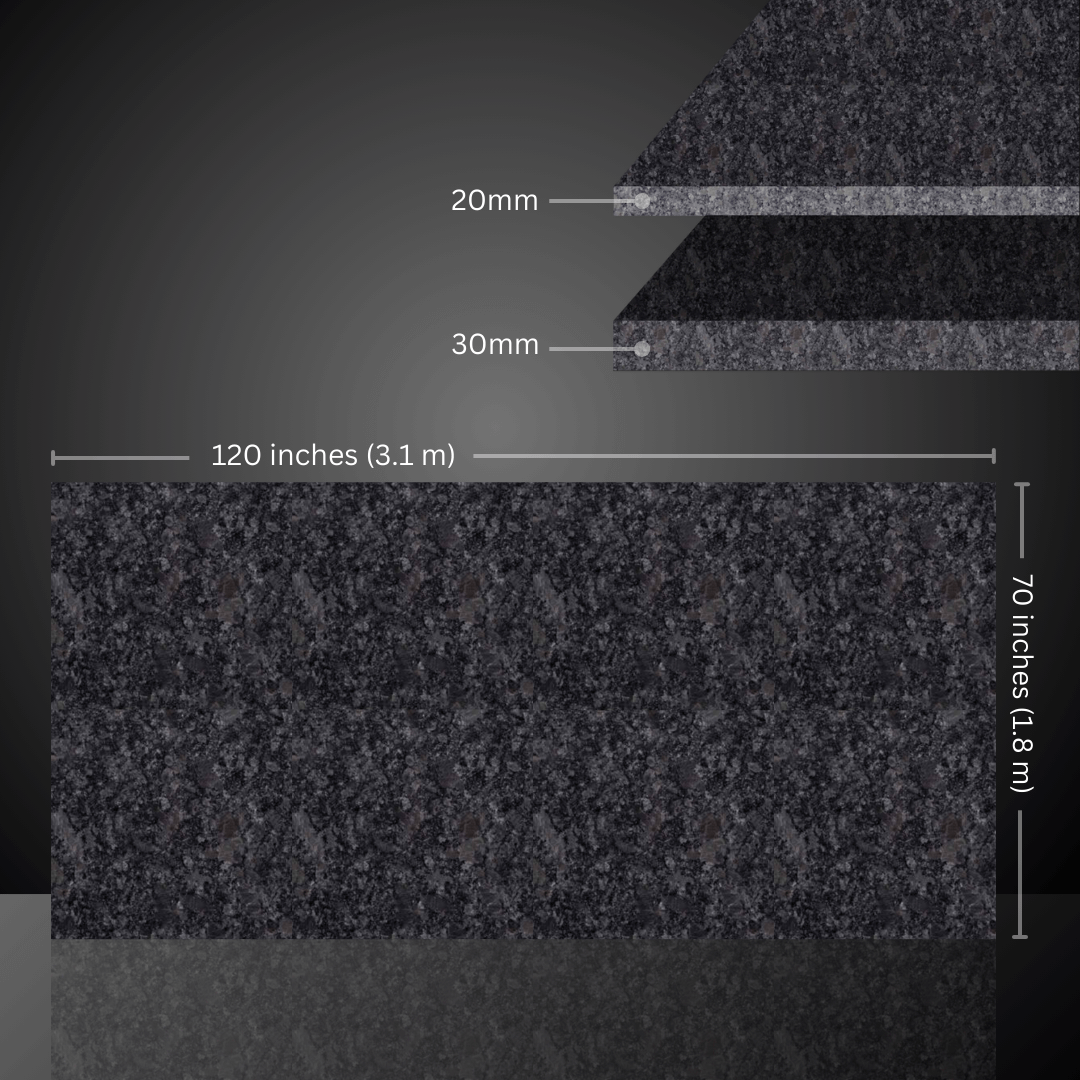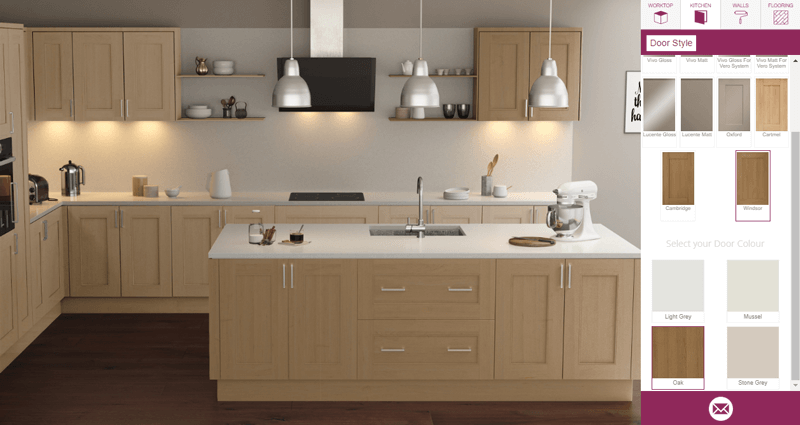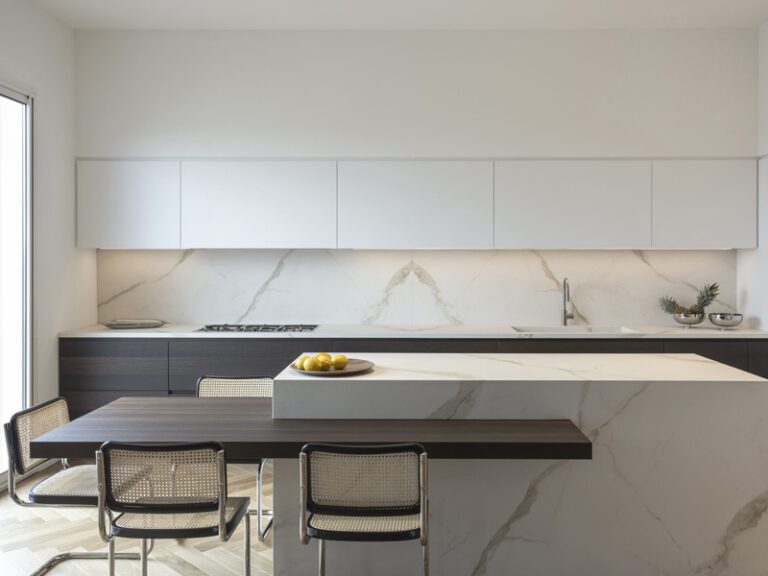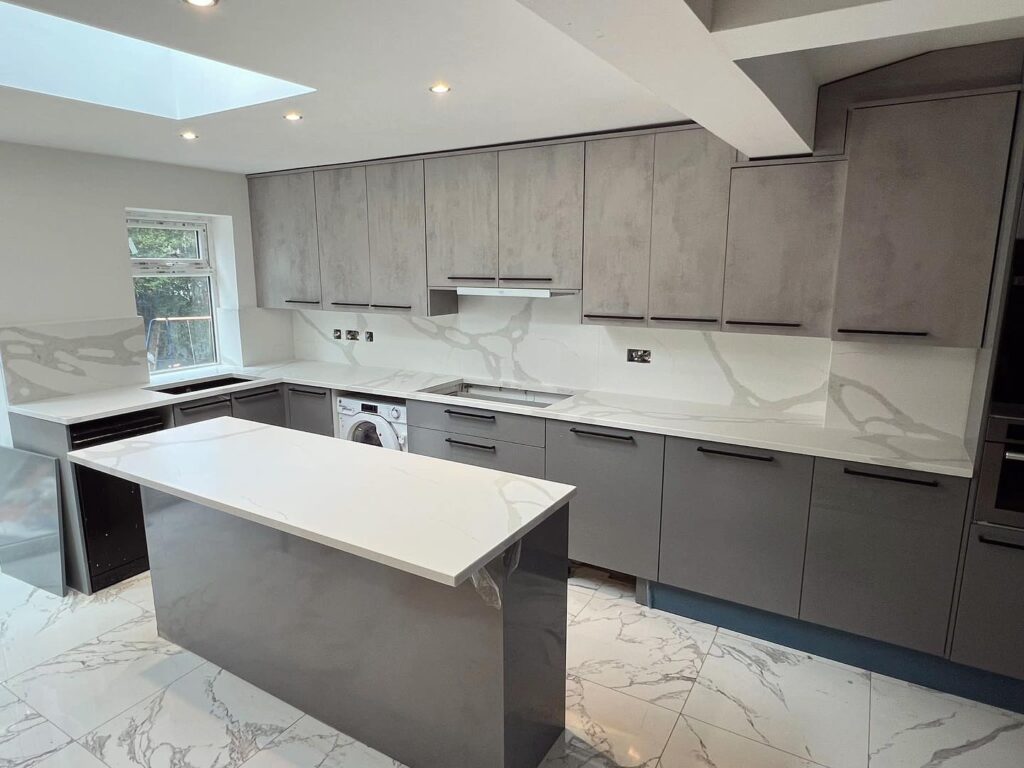

Granite countertops have long been a symbol of luxury and durability in kitchen design. Their timeless appeal, coupled with remarkable strength and resistance to heat and scratches, makes granite a popular choice for homeowners looking to enhance the aesthetic and functionality of their kitchens.
When considering granite countertops, one crucial aspect to take into account is the size of the granite slabs. The selection of the right slab size not only influences the visual impact of the countertop but also affects the installation process and overall cost. In this blog from the Granite Zone team, we will explore various aspects of granite slab sizes to help you get the kitchen countertops you desire hassle-free and at the right price.
Standard Granite Slab Sizes
Granite slabs are available in a range of standard sizes from quarries with the most common dimensions being 120 inches (3.1m) by 70 inches(1.8m). Most quarries that supply the retail market cut slabs with a 1.2-inch (30mm) or 0.8-inch (20mm) thickness.
We are experts at cutting slabs down to the right size for your kitchen and the design you have in mind. We can then install beautiful custom granite worktops that mirror your specific preferences exactly. Why not start by asking for some granite worktop samples or get a no-obligation kitchen worktop quote from us?
Granite Countertop Sizes & Features
Of course, the size and layout of your kitchen play a pivotal role in determining the appropriate granite slab size to order. In smaller kitchens, it can prove cost-effective to use smaller standard-sized slabs to reduce the amount of cutting involved and avoid joints and seams. The same applies for larger kitchens. They will benefit from a design that utilises larger standard-sized slabs to reduce the number of seams and create a more seamless appearance.
The best solution is to take accurate measurements of the kitchen and talk to our team about getting the best quote available.
Kitchen Worktop Design Preferences
Your design preferences and the aesthetic you want to achieve in your kitchen will heavily influence the choice of granite slab sizes. Some homeowners prefer the classic look you achieve with several smaller slabs joined by a zig-zag of seams, while others opt for more contemporary large, sweeping uninterrupted surfaces.
Seams between granite slabs are inevitable in most granite countertop installations, especially in larger kitchens. The placement of seams is therefore a crucial consideration, as it can impact the overall look and feel of your kitchen. Smaller slabs will generally result in more seams, and their placement should be carefully planned to ensure a cohesive and visually appealing outcome.
The size of the granite slabs you choose will also have financial implications. Larger slabs tend to be more expensive due to the increased material costs and potential challenges in handling and transportation. Homeowners with budget constraints may need to find a balance between their desired slab size and the associated costs.
The installation process will be affected by the size of the granite slabs you choose. Larger slabs may require more effort and manpower to transport and install, potentially leading to higher installation costs. The good news is we are experts at kitchen countertop installation so can give you all the advice you need for a smooth and efficient process.
The Advantages of Small Granite Slabs
Size isn’t everything. Sometimes, depending on your kitchen design plans, smaller initial slabs can be the right choice. We have included three major advantages of small granite slabs below.
Smaller slabs are often more cost-effective to buy, making them a suitable choice for homeowners on a budget.
Smaller slabs are generally easier to handle during transportation and installation, reducing the risk of breakage or damage.
Smaller slabs offer greater flexibility in terms of design and seam placement, generally allowing for more creative and custom installations.
The Advantages of Large Granite Slabs
The advantages of going big might seem obvious. Who wouldn’t love a sweeping one-piece granite countertop as a key conversation piece in their kitchen? We have included more benefits below.
Larger slabs minimise the number of seams you need in each countertop, providing a more seamless and continuous appearance.
Homeowners seeking a modern, sleek contemporary design often opt for larger slabs to create expansive, uninterrupted surfaces.
Fewer seams mean fewer areas for potential dirt or moisture penetration, contributing to easier maintenance and, ultimately, a longer life.
Granite Slab Thickness & Profile
Because of the way the natural material is cut at the quarry granite worktops are available in 20mm and 30mm thicknesses. Any thicker than this and the worktop may potentially be too heavy for standard kitchen cupboard carcasses to support without additional reinforcement. Any thinner and the worktop can be prone to cracking.
Although thicknesses may come as standard, granite kitchen worktops offer a variety of edge profiles which allow homeowners to tailor the appearance of their countertops. Common edge options include bevelled, bullnose, ogee, eased and straight edges, each contributing to a distinct aesthetic. Bevelled edges add a subtle angle, bullnose edges provide a rounded finish, and ogee edges create elegant S-shaped curves. You might want to consider a straight edge for a clean, modern look too. Eased edges which feature a softened square edge are popular for their contemporary appeal.
Choosing the right edge profile for your granite worktop not only enhances visual appeal but also complements the overall style of your kitchen. Talk to us about your options.
Tips for Selecting the Right Granite Slab Size
Before making any decisions, accurately measure your kitchen to determine the available space for the countertop. Consider the layout, including the placement of appliances, sinks, and other fixtures.
Then, seek advice from design professionals or countertop specialists, like us, who can provide insights into the most suitable slab size for your kitchen based on your preferences As well as size and shape, we’ll encourage you to consider the pattern of the granite too. Some patterns may be better showcased on larger surfaces, while others might work well with smaller slabs and more seams.
Finally, it is vital to discuss the logistics of installation with your countertop installer. Transporting and handling of granite slabs is not always straightforward. Imagine being stuck with a granite slab that won’t fit through your kitchen door. As experts, we will make sure that doesn’t happen.
All-in-all, ordering granite in the right slab size is a question of striking a balance between your aesthetic preferences, budget constraints and practicalities.
If it all sounds complicated, don’t worry. The Granite Zone team is here to help.





